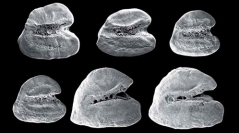

 Geodiversitas
30 (3) - Pages 577-592
Geodiversitas
30 (3) - Pages 577-592Until recently, only a single fossil species of the cyprinodontiform genus Aphanius was known from Anatolia (Turkey), mainly based on fossil otoliths. As Anatolia is a diversity hotspot of this genus, it was of peculiar interest to investigate recently found fossil otoliths of ?upper Pliocene-lower Pleistocene age from the Yassigüme section located in the Burdur Basin in southwest Anatolia. We studied the morphological relations to otoliths of extant Aphanius anatoliae sureyanus inhabiting present-day Lake Burdur by conducting Fourier shape and statistical analyses (principal components analysis [PCA], canonical discriminant analysis [CDA]). For further comparisons, we included a population of A. a. anatoliae (at Lake Salda) nearby Lake Burdur and one population of A. danfordii from the Kızılırmak River in northern central Anatolia. The contour of the fossil otoliths closely resembles that seen in the otoliths produced by the extant subspecies A. a. sureyanus from Lake Burdur. On the other hand, the fossil otoliths are distinctly different from those of the extant species A. danfordii. Furthermore, the fossil otoliths reveal more proximity to A. a. sureyanus than to A. a. anatoliae of that region, and both extant subspecies show a certain distance to one another in the CDA; thus we suggest that this might be explained by a diversification of the subspecies that had begun before the investigated fossil populations existed. Based on the strong similarity of the fossil otoliths with A. a. sureyanus, we conclude that they do not represent a new fossil species, and thus are preliminary denominated as †A. cf. anatoliae sureyanus.
Teleostei, Cyprinodontiformes, otolith, Neogene, Lake Burdur, Aphanius, Anatolia, Fourier analysis, freshwater biodiversity